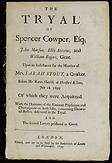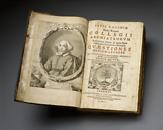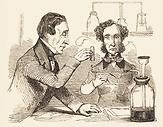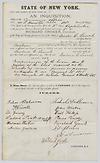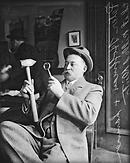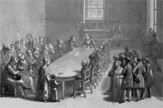The Rise of Forensics
Forensic medicine, also called "medical jurisprudence" or "legal medicine," emerged in the 1600s. As European nation-states and their judicial systems developed, physicians and surgeons participated more frequently in legal proceedings. By the late 1700s, medical jurisprudence had become a standard subject in the medical curriculum. In the early 1800s, Parisian medical professor Mathieu Orfila and others began to intensively study poisons and the decomposition of bodies.
To win acceptance, aspiring medical experts had to make their procedures, accomplishments, and themselves, visible. In the university, laboratory, courtroom, press, and even the pages of the medical treatise, forensic medicine had a theatrical aspect. The medical witness, the eminent professor, the autopsist, and the toxicologist all sought to dramatize their methods, findings, and professional identity.
Medico-legal questions
Forensic medicine first appeared as a distinct subject in works such as Paolo Zacchia's Questiones Medico-Legales (1621). These early treatises discussed medical questions commonly treated in courts: How could one determine whether an infant was stillborn or the victim of infanticide? Whether a woman was a virgin? Whether a body found in water was someone who had drowned or the victim of a disguised homicide?
The larger issues raised by the first wave of forensic treatises are still debated: What methods produce reliable knowledge? Who should we accept as an expert in a court of law? What role should experts play in criminal investigations, civil cases, and government policymaking? What constitutes a good society—and what role can forensic medicine play in achieving it?
Proliferating specialties
In the early 1800s, forensic medicine was not divided into distinct disciplines. Physicians and surgeons who performed autopsies and testified in court depended on a variety of sources for their income and provided expertise as needed. No regular system of payment was provided for expert testimony, laboratory analysis, or postmortem examination. Toxicology and forensic pathology were just emerging as distinct fields, and most autopsies were performed by physicians without any special training.
Today, forensics includes many disciplines, with dozens of specialties
and subspecialties drawing on expanding
scientific knowledge and
technological expertise as shown in this chart (PDF, 3.0 MB).
This document is in PDF format and requires Adobe Acrobat Reader.
The coroner's report
"The said Thomas Fitzpatrick came to his death by A Pistol shot wound of the chest, said pistol being fired by Officer George Smith of 16th Precinct on the corner of 9th Avenue and Thirteenth street on December 25 '83 about 6:30 AM and we are of the opinion that said shooting was entirely unjustifiable."
—Juror's verdict, coroner's inquisition, New York City, January 7, 1884
"I made an autopsy on the body of the deceased. He was a strong muscular man 5 feet 6 inches tall, smooth shaven and hair closely cropped. A penetrating scalp wound was found on the Right Parieto-Occipital Suture about an inch and a half in length. A pistol shot wound of the Left Breast about two inches from the median line in the intercostals space was seen…. Death in my opinion was due to Exhaustion from Traumatic Pleuro Pneumonia following Pistol Shot Wound of the Left Breast."
—W. J. G. Messemer, M.D., coroner's inquisition, New York City, January 7, 1884
In late medieval England, it became customary to transcribe the coroner's view of the body onto paper, in the form of a written inquest. Over the following centuries, the documentation associated with the coroner and the forensic medical report gradually expanded, a paper trail of transcripts, depositions, and death certificates.
Eighteenth-century Britain and America had only rudimentary policing structures, and physicians and surgeons were rarely called upon to participate in coroners' inquests and criminal proceedings. Coroners' reports and testimony were handwritten, short, and varied widely from case to case, and locale to locale.
Over the course of the 19th century, investigations of sudden or suspicious deaths became institutionalized and bureaucratic—police departments and court systems grew exponentially; nations began to require formal death certificates to aid in the collection of mortality statistics—and coroners began to employ physicians on a regular basis. Pathological anatomy and toxicology became more complex and sophisticated, and so did legal codes and police investigative procedures. The coroner's report became more elaborate—the entire record of an investigation—and the legal and medical language of the inquest became more technical. The format of the printed form expanded; paperwork proliferated and became more standardized. In our time, this trend has continued, aided by computerization.
The coroner's office on trial
"Thanks to our see-no-evil coroner system, 5,000 murderers are going to commit their crimes without risk of detection in the coming year."
—True magazine, 1958
The campaign to abolish the office of the coroner began, in America, in the late 19th century. As newspapers filled with reports of corrupt coroners who extorted money, accepted bribes, or slanted findings to cover up murders and other crimes, progressives demanded that elected coroners be replaced by appointed medical examiners—doctors trained in forensic pathology, hired on merit.
Over the first three quarters of the 20th century, some jurisdictions adopted the medical examiner system. Others retained the coroner's office—although some coroners today are board-certified forensic pathologists. Unfortunately, some medical examiners, like some coroners, have not always met the highest scientific, legal, and ethical standards. Efforts to ensure the impartiality and competence of forensic investigations continue.
Both the coroner system and medical examiner system are currently used in the United States (PDF, 4.6 MB) with some jurisdictions using a hybrid of both.
This document is in PDF format and requires Adobe Acrobat Reader.
Forensics on trial
Cause and manner of a death are not always evident—even after visual examination and dissection of the body. Over the centuries, forensic medicine has developed technologies of visibility, ways of seeing things that would otherwise be undetectable.
- Post-mortem examination helps us look into the human body for concealed wounds, foreign objects, and other evidence.
- Chemical analysis helps us see invisible traces of poison, establishes the identity of body, body parts and fluids, and helps link the victim's body to the perpetrator and the crime scene.
- The microscope helps us see tiny lesions, crystals, microbes, and distinguish hairs and fibers.
- Spectroscopic analysis of blood, tissues, and material found on or near the body, helps us distinguish and match trace elements that link the body of the victim, crime scene, and perpetrator.
But no method is infallible. The tests and procedures of forensic medicine have not always stood up to the scrutiny of judges, expert witnesses, lawyers, professional peers, and the public. Over time, the experience of forensic medicine in the courtroom has led to improvements in science, technology, and investigative procedures. But the process has been uneven—scientific experts have at times been suffered embarrassment—and forensic science has not always prevailed.
